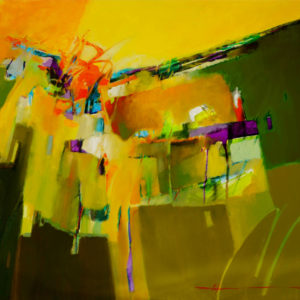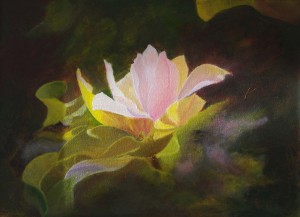Dear Artist,
If painting is like navigating, you might want to put down your phone. Neuroscientists at the University College London scanned the brains of London cabbies and discovered that the volume of their hippocamps — the part responsible for spatial memory, visualization and narrative — was larger than average. As possessors of “The Knowledge” — knowing by heart over 320 routes, 25,000 streets and 20,000 landmarks — London cabbies are said to have had an atlas of the city transplanted into their brains. The magic is that “The Knowledge,” unlike a smart phone algorithm offering every driver the same directions, allows the cabbie to create novel routes based on a mastery of experience and to retrace, tweak and embellish these routes over time.

The Enchanted Owl, 1960
Stonecut on paper
Printer: Eegyvudiuk Pootoogook
60.9 x 66 cm
by Kenojuak Ashevak (1927-2013)
In her 2019 book Wayfinding: The Science and Mystery of How Humans Navigate the World, scientific journalist Mara O’Connor proposes that as an open-ended exploration under our own power, navigation is a process that fires up our senses, feelings and motivations and connects us to the physical world. Getting lost, she says, is as important as knowing how to get somewhere, as the process of finding our own way builds cognitive and creative skills.
O’Connor says we use two basic strategies to navigate under our own steam. When we’re in a new city and need to find a place, we may ask for directions and then follow landmarks to get there. This is called the “spatial learning strategy,” where our hippocampus puts a pin in a memory spot and attaches a visual, a narrative or a feeling that can be retrieved later. Once we know where we are, we may then move over to the “caudate nucleus-dependent strategy” whereby we switch to a kind of autopilot that signals our brain to turn left or right in response to a cue we no longer have to think about or actively recall. This habit-style navigation lessens the cognitive load, which allows us to flesh out further benefits of the route, like resting spots or other resources — or even daydream.
Humans have been orienting themselves with stars, sand, snow, wind and waves with endless diversity — forever. Memory has been the unifying tool, regardless of environmental or geo-centric cues. Whatever our method of self-powered navigation, it comes from the same spot in our brains that creates stories about the past and future, which, to O’Connor, is a definer of humanity. When you snowmobile past a landmark on the Baffin Island tundra, she says, be like the Inuit hunter and turn around to study it from the other side to memorize its features from the new angle. Now added to your library of visual and emotional experience, your storytelling gains depth and turns locations into places of significance and connection, which is how you find your way.
Sincerely,
Sara
PS: “Make voyages! Attempt them… there’s nothing else.” (Tennessee Williams)

Six-Part Harmony, 2012
Stonecut and stencil on paper
Printer: Qavaulau Manumle
62 x 99.5 cm
by Kenojuak Ashevak
Esoterica: O’Connor writes that the role of exploration, especially in children, is actually integral to the development of the hippocampus and explains why so many of us experience that phenomenon of “childhood amnesia.” Apparently, our memories of early childhood are spotty because our hippocamps had not yet developed. Studies show that by outsourcing navigation to external tools like Google maps and turn-by-turn GPS apps in our cars, the hippocampus goes a little quiet, crippling our ability to recall detail and gather nuanced information. Neuroscientists even have a name for it: “Digital Dementia.” Like a bicep that atrophies when held in a sling for too long, when we chronically neglect evolutionary endowed skills like memory and navigation, our hippocamps appear shrunken in the same way as the brain scans of people who suffer from depression, PTSD and Alzheimer’s Disease. The good news, says O’Connor, is that “this part of the brain is very plastic and can be affected by experience. It can be nourished.”
 “Unexpected travel suggestions are dancing lessons from God.” (Kurt Vonnegut, Jr.)
“Unexpected travel suggestions are dancing lessons from God.” (Kurt Vonnegut, Jr.)
The Letters: Vol. 1 and 2, narrated by Dave Genn, are available for download on Amazon, here. Proceeds of sales contribute to the production of The Painter’s Keys.
“To travel hopefully is a better thing than to arrive.” (Robert Louis Stevenson)
Featured Workshop
Neutrals enhance your paintings, edges provide sensuality color adds excitement and value holds the paintings together. Successfully combing these elements guarantees a painting that is dynamic.
Held at Gwen Fox’s private Art Sanctuary in Taos, New Mexico. Her 100-year-old adobe home is the perfect environment to inspire and renew your creativity.
There will be private critiques that empower, glorious breakthroughs while basking in a safe environment in which to grow as an artist.
Limited to 10 artists. This workshop will fill fast.
Featured Artist
I am a self taught artist, I work in oil, Acrylic and watercolour also in Pastels. Started painting In Ashcroft with Mr. Campbell. I taught my self how to paint by studying professional artists’ work through reading, TV programs, educational DVD and work shops.







11 Comments
Yes! I use to know everyone’s phone numbers, now thanks to technology, I’m lucky if I remember my own! Ever so happy to be a painter who uses visual cues to guide my hand and NOT technology!
I find this very powerful, Sara. Thank you.
This gives me courage to do new and sometimes difficult things. Getting lost is part of the journey. Thanks Sara
Makes me wonder why I have always been directionally challenged.
WOW!!
This is absolutely beautiful to me!! Thank you, Sara. Hittin’ on all 12 cylinders with this article.
In Portland, Oregon there are so many different ways to get someplace, I sometimes love to take different routes just for a change of scenery, to scope out what new developments (art/architecture/traffic patterns/retail establishments) may be going on that I may not be aware of. It frustrates some of my “directionally challenged” friends. They just want to know one way so the “next” time they won’t get lost.
When I travel to different cities, I challenge myself to search, map out, find different landmarks to locals of interest and play those mappings in my head (later) just to see if I could get “there” were I to return to that city. (lol…in this life I will never be bored)
I realize that this article is not about geographical location. It is cool to know there is this “hippocampus” at work, fully active, which explains my penchant for seeking the different, the unusual. My “directional habits” engage in my creativeness as well. I thought I was a bit crazy. But now I have an understanding of my desire to meander. While painting and driving. Thank you for this!
This thought came to me after reading this interesting letter: In navigating our paintings does the mirror tool of looking backward at it, like the Inuit traveler memorizing the landmarks back, offer a possible route into our paintings and know it better? Painting like a journey does rely on memory and how we apply it. Thank you Sara.
Thanks Sara. A different way of looking at things. Totally interesting how the brain works.
“digital dementia”– I am SO hanging on to this one. I can’t count the number of people I’ve heard say that their fabulous GPS system screwed up in ways small and large. I remember reading about some guy–this is not funny, it’s desperately sad– whose wife died when he kept driving following the computer while ignoring the signs saying the road ahead was closed and the bridge was out. Hoping it’s apocryphal but probably not.
But how amazing and impressive that London cabbies have so much knowledge at hand that it has affected their physical brains. You’ve gotta look at the road, then the map, back to the road in front of you, a constant set of subtle adjustments–even when you’re creating the road as you go.
Thanks as always Sara!
Thank you Sara for this information. My husband and I, to the awe of some of our friends and family, leave on trips with no destination in mind. We follow the road and wander wherever we please, mostly on the labyrinth of small secondary prairie highways. By doing this we meet interesting people, see places that most people miss and find some delightful spots! The road less traveled is always the most interesting. There is nothing as boring as a superhighway!
In painting, as well, using your own imagination and exploring your own mind is stimulating!
As they say, “good job!”
Kind of reminds me of the great quote: “Not all those who wander are lost.” J. R. R. Tolkien
Love J.R.R. Tolkien’s quote. Thank you for sharing it. Thank you as always, Sara, for sharing your letter. There’s always a morsel of wisdom to gain.